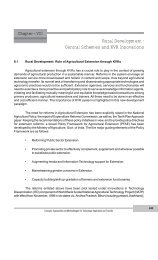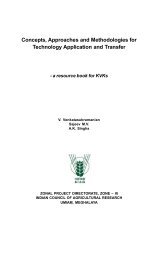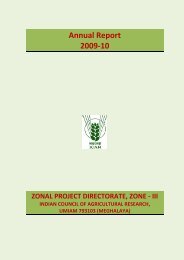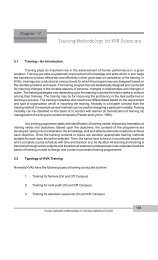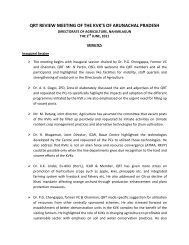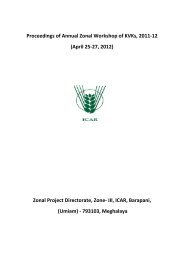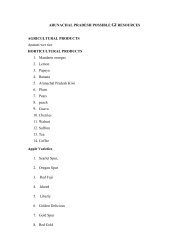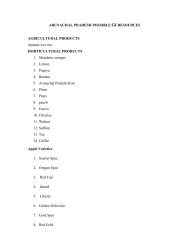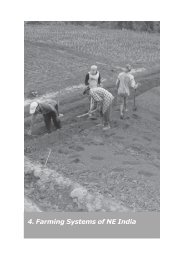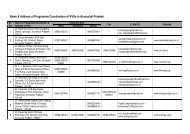Sajeev M.V, V. Venkatasubramanian & A.K. Singhacircumstances intensive mixed systems may develop. In all cases, enabling infrastructure and theavailability of technical and market information will be important influences on system evolution.The five key categories of determinants influencing farming system evolution as identified anddescribed by FAO is provided in the following sections.Natural resources and climateThe interaction of natural resources, climate and population determines the physical basis for farmingsystems. During the early stages of development, increased population generally leads to an expansionin cultivated area and, in many cases, conflict between the different users of land and water resources.Once most good quality land is already exploited, further population increases tend to lead to theintensification of farming systems. As forests and woodlands come under greater pressure, biodiversityis threatened and there may be growing tension between development and conservation goals. Thesetrends have often been exacerbated by colonial and post-colonial forces that have concentrated indigenousor minority peoples on poorer quality land - thus aggravating the degradation problem.Over the past four decades the amount of land under cultivation, including permanent crops, hasincreased by more than one quarter - to just over one billion ha. However, the rapid growth of populationin recent years has meant that the area of cultivated land per capita in developing countries hasdeclined by almost half since the 1960s.Since the 1960s, pasture and grazing land has expanded by a total of 15 percent in developing regions,to around 2.2 billion ha in 1994. Much of this expansion was achieved at the expense of forest andwoodland, which declined to about 2.3 billion ha over the same period. Annual growth rates in cultivatedarea vary considerably between the regions, as shown in Box 1.2. By far the highest growth rates wereexperienced in Latin America and Caribbean - 1.26 percent per annum as compared with only 0.18percent per annum in South Asia. It is worth noting that, during this period, average cropping intensityrose in total by only five percent; suggesting that growth in output has resulted mainly from yieldincreases and area expansion rather than from higher cropping intensity.It is estimated that an additional 1.8 billion ha of land of ‘acceptable’ quality remains available forfuture agricultural use, but this seemingly favourable scenario is seriously constrained by a numberof factors. Much of the land categorized as suitable for agriculture is only suited to a narrow rangeof crops (e.g. olive trees in North Africa). Secondly, more than 90 percent of available land is inLatin America and Sub-Saharan Africa, which means that further expansion is simply not an optionfor most of North Africa, Eastern Europe, Asia and Middle East. Even in those areas where potentialfor expansion does appear to exist, over 70 percent of available land is estimated to suffer from oneor more soil or terrain constraints. As a result of these factors, the projected expansion (FAO2000a) in cultivated area in developing regions to 2030 is only half the historic rate - adding about120 million ha to the current total. Strikingly, however, by the year 2030, and despite the additionof well over two billion people to the population of developing countries, the average amount ofcultivated land available for each person engaged in agriculture may actually increase due to thestabilization of agricultural populations.<strong>Farming</strong> <strong>Systems</strong> of North East India13
Sajeev M.V, V. Venkatasubramanian & A.K. SinghaDespite the typically high cost of developing irrigation systems, irrigated land use has risen atthree times the rate of overall expansion of farmland; total irrigated area in developing countrieshas doubled since 1961 - to 197 million ha. This supports the contention that many areas of thedeveloping world have already faced constraints to further expansion for several decades, if notlonger. However, intensification through irrigation has its limits. At present, it consumes about 70percent of the total volume of fresh water used by humans, but this proportion is likely to declineduring the coming 30 years as urban and industrial use grows. Despite the fact that only sevenpercent of total renewable water resources in developing countries are currently exploited, thesecompeting demands, together with the fact that much of the available water is not located in areasof agricultural need, is expected to reduce current rates of irrigation growth.The expansion of agriculture, plus changes in production technologies, has resulted in a decrease inagro-biodiversity in recent decades. In addition to the well publicized disappearance of indigenous floraand fauna, there has been a considerable reduction in the number of varieties cultivated, which hasaffected in particular the main cereal crops: wheat, maize and rice. A similar loss of biodiversity hasoccurred among domestic animals. However, modern plant breeding may go some way to reversing thistrend by making it easier to maintain genetic material, and by creating a wider gene pool of modernvarieties.Agriculture currently contributes about 30 percent of the global anthropogenic emission of greenhousegases. Growth in the production of these gases by crops is expected to slow down in future, butmethane production by livestock could increase substantially. Accumulated evidence (IPCC 2001) nowstrongly suggests that impacts from global climate change will be significant. Average global surfacetemperatures are expected to rise by an estimated 1.4 to 5.8°C in the next 100 years, while thefrequency of climatic extremes (temperatures, precipitation and winds) is expected to increasedramatically. Models based on the Intergovernmental Panel on Climate Change (IPCC) scenario of a onepercent increase in greenhouse gases annually, predict that within 80 years extremes currentlyexperienced only once a century will become normal. Higher temperatures will inevitably lead to a risein sea levels - estimated at between 0.1 and 0.9 metres over this century.There is little doubt that both agriculture and food security will be affected by climate change. Not onlywill crop yields change, but huge investments in infrastructure could also be required. Among theimpacts predicted by the IPCC Working Group is a reduction in potential crop yields in most tropical andsub-tropical regions and, if temperature increases are towards the higher end of the predicted range,also in mid-latitudes. Another recent study has estimated that crop yields could decline by one-fifth inmany developing countries (Fisher et al 2001). Water availability - particularly in the sub-tropics - isexpected to diminish; although some areas such as South East Asia, may have to cope with greatervolumes of water as a result of more intense monsoon activity. A widespread increase in the risk offlooding is anticipated, as a result of rises in sea level and increased severity of precipitation fromstorms, hurricanes and monsoons. Labour availability may be affected by the expected increase in thetransmission of diseases; both vector borne (e.g. malaria), and water borne (e.g. Cholera). Overall, theincreased variability of climate, and thus agricultural productivity, substantially increases the risk facedby farmers, with concomitant reduction in investment and input use.14<strong>Farming</strong> <strong>Systems</strong> of North East India
- Page 3 and 4: We sincerely acknowledge theconstan
- Page 5 and 6: PREFACEFarming System Research/Exte
- Page 7 and 8: 2. Methodology2.1.0 Selection of Di
- Page 9 and 10: 4.2.3 Farming Systems of Darrang 41
- Page 11 and 12: 5.3.3 Research priorities and strat
- Page 13 and 14: 6.6 Development strategies for Naga
- Page 15 and 16: Blank Page
- Page 17 and 18: Sajeev M.V, V. Venkatasubramanian &
- Page 19 and 20: Sajeev M.V, V. Venkatasubramanian &
- Page 21 and 22: Sajeev M.V, V. Venkatasubramanian &
- Page 23 and 24: Sajeev M.V, V. Venkatasubramanian &
- Page 25 and 26: Sajeev M.V, V. Venkatasubramanian &
- Page 27: Sajeev M.V, V. Venkatasubramanian &
- Page 31 and 32: Sajeev M.V, V. Venkatasubramanian &
- Page 33 and 34: Sajeev M.V, V. Venkatasubramanian &
- Page 35 and 36: Sajeev M.V, V. Venkatasubramanian &
- Page 37 and 38: Sajeev M.V, V. Venkatasubramanian &
- Page 39 and 40: Sajeev M.V, V. Venkatasubramanian &
- Page 41 and 42: Sajeev M.V, V. Venkatasubramanian &
- Page 43 and 44: Sajeev M.V, V. Venkatasubramanian &
- Page 45: Sajeev M.V, V. Venkatasubramanian &



